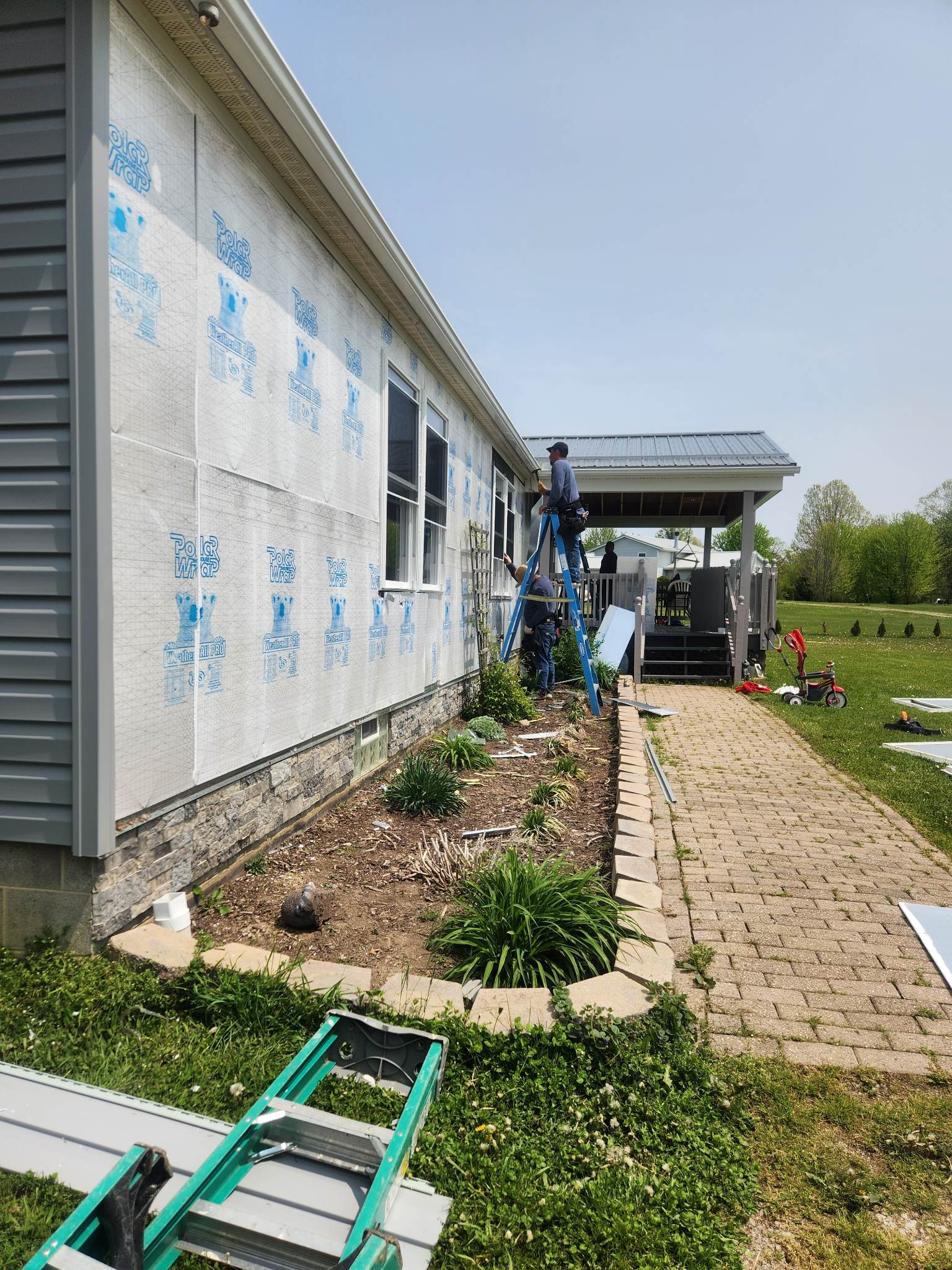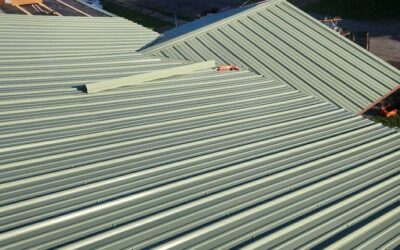5 Signs of Storm Damage to Your Roof: How to Spot the Issues and Protect Your Home
Severe storms can cause significant damage to your home, and one of the most vulnerable parts of your property is your roof. The roof plays a critical role in protecting your home from the elements, and storm damage can compromise its integrity. Often, storm damage can go unnoticed, but there are several key signs to watch out for that may indicate your roof has suffered from a recent storm.
In this blog post, we will explore five common signs of storm damage to your roof, including dents on your gutters and things around your property, asphalt granules in your gutter or on the ground, missing, lifted, or creased shingles, dents in roof vents and flashing, and tree limbs or fallen trees hitting your roof. Recognizing these issues early can save you time, money, and stress when it comes to repairs.
1. Dents on Your Gutters and Things Around Your Property
One of the first signs that your roof may have been damaged during a storm is the appearance of dents on your gutters or other objects around your property. Hailstorms, high winds, and flying debris can cause damage not only to your roof but also to your gutters, siding, and other external features of your home.
If you notice dents on your gutters or things like your outdoor furniture, fence, or vehicles, this could be a sign of hail or debris impact. While it’s easy to spot dents on gutters or metal siding, it’s important to inspect the area around your home for other signs of damage. If debris from trees or heavy winds has hit the roof, you may also find evidence of these impacts around the property.
How to Check for Damage:
- Inspect your gutters closely for any visible dents, punctures, or cracks.
- Look for areas around your property where debris might have caused damage, such as trees, shrubs, or lawn ornaments.
- Check for damage to your siding, windows, and outdoor furniture.
If you notice that your gutters have significant damage, it could be a sign that your roof may have taken a hit as well. Hail or falling debris can leave dents or even create holes in the roof, causing long-term problems if not addressed quickly.
2. Asphalt Granules in Your Gutter or on the Ground
Asphalt shingles are a popular roofing material, and they feature a layer of granules that protect the shingles from the sun’s harmful UV rays and help with waterproofing. After a storm, it’s common to find asphalt granules in your gutters, driveway, or on the ground around your home. This is a significant sign of storm damage to your roof.
When hailstones, strong winds, or flying debris hit the roof, they can dislodge these granules, causing them to end up in your gutters or on the ground below. Missing granules can expose the shingles to further wear and tear, reducing their lifespan and efficiency in protecting your home.
How to Check for Damage:
- Examine your gutters and downspouts for a buildup of asphalt granules.
- Check the area around your property for granules on the ground.
- Inspect the shingles themselves for signs of bald patches or areas where granules are missing.
If you notice a significant number of granules in your gutters or around the yard, this could indicate that your roof has been damaged during the storm. Depending on the extent of the damage, you may need to consider replacing the affected shingles.
3. Missing, Lifted, or Creased Shingles
Shingles are designed to protect your roof and home from water damage, and any disruption to their structure can lead to serious leaks and moisture buildup. After a storm, it’s essential to check your roof for any signs of damage, such as missing, lifted, or creased shingles. These issues are often caused by high winds, hail, or flying debris.
- Missing Shingles: High winds during a storm can cause shingles to become dislodged, leaving your roof exposed. This is one of the most noticeable signs of damage and should be addressed immediately to avoid further complications, such as leaks.
- Lifted Shingles: Lifted shingles are often caused by strong winds or hail. They can leave your roof vulnerable to water penetration and can cause the shingles to deteriorate over time.
- Creased Shingles: A crease in a shingle often occurs when debris or hail impacts the roof, bending or folding the shingle. Creased shingles may not always be as obvious as missing shingles but can still compromise the integrity of the roof.
How to Check for Damage:
- From the ground, use binoculars to inspect your roof for missing, lifted, or creased shingles.
- If possible, safely access your roof with a ladder or request a professional roofing inspection to check for more severe damage.
- Pay attention to areas where shingles may be loose, bent, or visibly damaged.
Missing, lifted, or creased shingles can leave your roof susceptible to leaks, and it’s important to address these issues quickly to prevent further damage to your home.
4. Dents in Roof Vents, Roof Flashing, and Shingles
Roof vents, flashing, and shingles are some of the most vulnerable areas on your roof during a storm. When hailstones or debris hit your roof, they can leave behind visible dents or dings in these components. While the damage might not always be immediately noticeable, it’s essential to check for dents in these areas to ensure the roof’s integrity.
- Roof Vents: Roof vents allow hot air to escape from your attic and help regulate temperature and humidity levels. Hail or debris can dent roof vents, which can impair their ability to function properly and lead to long-term issues such as mold growth or excess heat buildup in the attic.
- Roof Flashing: Flashing is a critical component of your roof system that prevents water from infiltrating areas like chimneys, vents, or valleys. Dents in roof flashing caused by hail or debris can lead to leaks and water damage.
- Shingles: Hail or debris impacts can also cause dents or indentations in the shingles themselves, especially if they are made of softer materials. While minor damage might not cause immediate issues, prolonged exposure to weather can weaken shingles over time.
How to Check for Damage:
- Inspect roof vents for any visible signs of dents, cracks, or punctures.
- Check roof flashing around chimneys, vents, and valleys for any signs of denting or bending.
- Examine shingles for any dents or indentations that could indicate storm damage.
Dents in these critical roof components can lead to larger issues, such as leaks, water infiltration, or even reduced airflow in your attic. It’s important to address any damage to roof vents, flashing, or shingles promptly to prevent long-term issues.
5. Tree Limbs or a Full Tree Hitting Your Roof
Perhaps one of the most obvious signs of storm damage to your roof is the presence of tree limbs or even an entire tree that has fallen onto your roof. During severe storms, high winds can uproot trees or break branches, causing them to fall on your roof. Tree limbs can cause significant damage, such as punctures, dents, or even holes in the roof, depending on their size.
How to Check for Damage:
- Look for broken or fallen tree limbs on your roof, in your yard, or around the property.
- Inspect your roof for punctures, dents, or missing shingles in areas where tree limbs may have impacted.
- Check for signs of structural damage to the roof decking, especially if a large branch or full tree has fallen.
A tree limb or full tree on your roof can cause extensive damage, so it’s important to have your roof inspected as soon as possible. Even if the damage seems minor, it can lead to leaks and other issues that require professional repair.
Conclusion
Storm damage to your roof can lead to costly repairs if not addressed quickly. By knowing the signs to look for, such as dents on your gutters and surrounding property, asphalt granules in your gutters, missing or lifted shingles, dents in roof vents and flashing, and tree limbs or fallen trees hitting your roof, you can catch problems early and take the necessary steps to prevent further damage.
If you suspect that your roof has been damaged by a storm, it’s always a good idea to schedule a professional roof inspection. A roofing contractor can help assess the extent of the damage and recommend the appropriate repairs to restore your roof’s function and protect your home from the elements. Don’t wait—taking action after a storm can save you time, money, and stress in the long run.
If you’re in Northeast Ohio and need professional roofing services, feel free to reach out to S&K Construction and Remodeling. We can help assess storm damage and ensure your roof is in top condition!
 (440) 307-2060
(440) 307-2060


